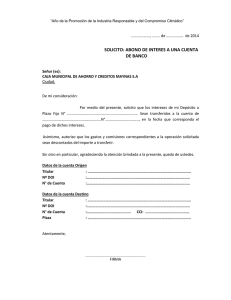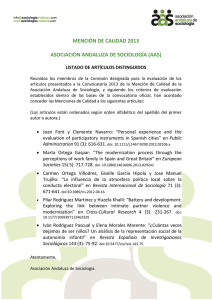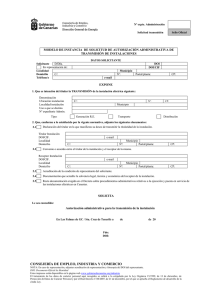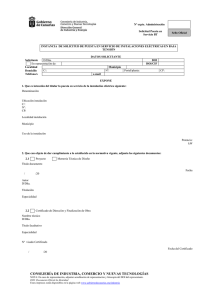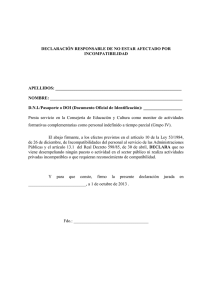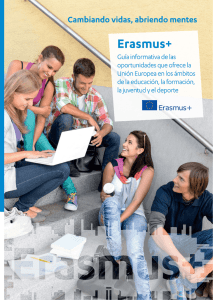Beetles have maternal instincts - Smithsonian Tropical Research
Anuncio
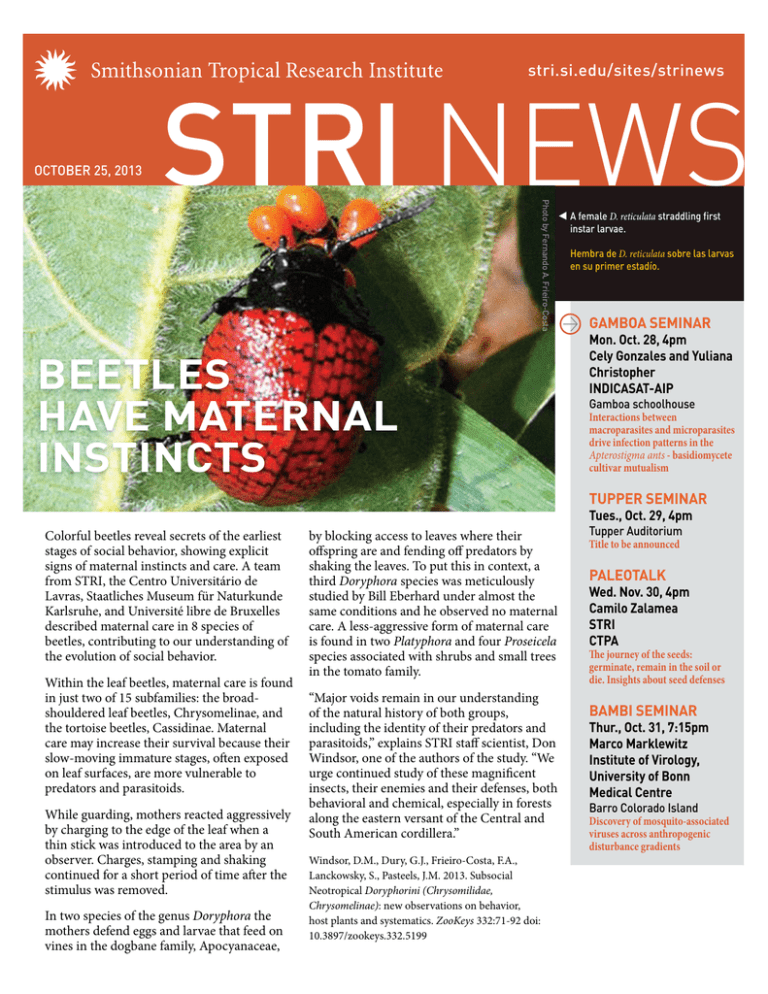
STRI NEWS stri.si.edu/sites/strinews OCTOBER 25, 2013 Photo by Fernando A. Frieiro-Costa Beetles have maternal instincts A female D. reticulata straddling first instar larvae. Hembra de D. reticulata sobre las larvas en su primer estadío. GAMBOA SEMINAR Mon. Oct. 28, 4pm Cely Gonzales and Yuliana Christopher INDICASAT-AIP Gamboa schoolhouse Interactions between macroparasites and microparasites drive infection patterns in the Apterostigma ants - basidiomycete cultivar mutualism TUPPER SEMINAR Tues., Oct. 29, 4pm Colorful beetles reveal secrets of the earliest stages of social behavior, showing explicit signs of maternal instincts and care. A team from STRI, the Centro Universitário de Lavras, Staatliches Museum für Naturkunde Karlsruhe, and Université libre de Bruxelles described maternal care in 8 species of beetles, contributing to our understanding of the evolution of social behavior. Within the leaf beetles, maternal care is found in just two of 15 subfamilies: the broadshouldered leaf beetles, Chrysomelinae, and the tortoise beetles, Cassidinae. Maternal care may increase their survival because their slow-moving immature stages, often exposed on leaf surfaces, are more vulnerable to predators and parasitoids. While guarding, mothers reacted aggressively by charging to the edge of the leaf when a thin stick was introduced to the area by an observer. Charges, stamping and shaking continued for a short period of time after the stimulus was removed. In two species of the genus Doryphora the mothers defend eggs and larvae that feed on vines in the dogbane family, Apocyanaceae, by blocking access to leaves where their offspring are and fending off predators by shaking the leaves. To put this in context, a third Doryphora species was meticulously studied by Bill Eberhard under almost the same conditions and he observed no maternal care. A less-aggressive form of maternal care is found in two Platyphora and four Proseicela species associated with shrubs and small trees in the tomato family. “Major voids remain in our understanding of the natural history of both groups, including the identity of their predators and parasitoids,” explains STRI staff scientist, Don Windsor, one of the authors of the study. “We urge continued study of these magnificent insects, their enemies and their defenses, both behavioral and chemical, especially in forests along the eastern versant of the Central and South American cordillera.” Windsor, D.M., Dury, G.J., Frieiro-Costa, F.A., Lanckowsky, S., Pasteels, J.M. 2013. Subsocial Neotropical Doryphorini (Chrysomilidae, Chrysomelinae): new observations on behavior, host plants and systematics. ZooKeys 332:71-92 doi: 10.3897/zookeys.332.5199 Tupper Auditorium Title to be announced PALEOTALK Wed. Nov. 30, 4pm Camilo Zalamea STRI CTPA The journey of the seeds: germinate, remain in the soil or die. Insights about seed defenses BAMBI SEMINAR Thur., Oct. 31, 7:15pm Marco Marklewitz Institute of Virology, University of Bonn Medical Centre Barro Colorado Island Discovery of mosquito-associated viruses across anthropogenic disturbance gradients P. microspina female tending their larvae on their food plant belonging to the tomato family. Hembra de P. microspina atendiendo sus larvas en la planta de la que se alimentan, que pertenece a la familia del tomate. Photo by Don WIndsor Los escarabajos tienen instintos maternales Los escarabajos coloridos revelan secretos de las primeras etapas de la conducta social, mostrando signos explícitos de instintos y atención materna. Un equipo del Instituto Smithsonian de Investigaciones Tropicales, el Centro Universitario de Lavras, Staatliches Museum für Naturkunde Karlsruhe, y la Universidad Libre de Bruselas se describieron la atención materna en 8 especies de escarabajos, lo que contribuye a nuestra comprensión de la evolución del comportamiento social. “Aún se mantienen vacíos principales en nuestra comprensión de la historia natural de ambos grupos, incluyendo la identidad de sus depredadores y parasitoides”, explica el científico del Instituto Smithsonian en Panamá, Don Windsor, uno de los autores del estudio. “Instamos al estudio continuo de estos magníficos insectos, sus enemigos y sus defensas, tanto del comportamiento y químicos, especialmente en los bosques a lo largo de la vertiente oriental de la cordillera Central y Sur de América.” Dentro de los crisomélidos, la atención materna se encuentra en sólo dos de las 15 subfamilias: los crisomelinos, Chrysomelinae y los escarabajos tortuga, Cassidinae. La atención materna puede aumentar su supervivencia debido a que sus estados inmaduros de movimiento lento, a menudo expuestos en superficie de las hojas, son más vulnerables a los depredadores y parasitoides. Windsor, D.M., Dury, G.J., Frieiro-Costa, F.A., Lanckowsky, S., Pasteels, J.M. 2013. Subsocial Neotropical Doryphorini (Chrysomilidae, Chrysomelinae): new observations on behavior, host plants and systematics. ZooKeys 332:71-92 doi: 10.3897/zookeys.332.5199 Mientras que los cuidan, las madres reaccionaron agresivamente atacando hasta el borde de la hoja cuando un observador introdujo un palo delgado en el área. El ataque, los pisotones y la agitación continuaron durante un corto período de tiempo después de que se eliminara el estímulo. Larvas de D. paykulli mudándose a una nueva hoja seguidos de su madre. Photo by Sunshine Van-Bael En dos especies del género Doryphora las madres defienden los huevos y las larvas que se alimentan de la enrredadera de la familia de las adelfas, las Apocyanaceae, bloqueando el acceso a las hojas, donde están sus hijos y ahuyentando a los depredadores agitando las hojas. Para poner esto en contexto, una tercera especie Doryphora fue estudiada minuciosamente por Bill Eberhard casi bajo las mismas condiciones y no observó cuidado maternal alguno. Una forma menos agresiva de la atención materna se encuentra en dos especies de Platyphora y cuatro especies de Proseicela asociadas con arbustos y árboles pequeños en la familia del tomate. D. paykulli larvae moving to a new leaf followed by their mother. Photo by Jorge Morales Source/Fuente: Stanley Heckadon Congratulations to Eudocia Rodriguez! Eudocia Rodriguez, a senior at the Colon Campus of the University of Panama, won a scholarship from the Smithsonian Institution Women’s Committee. The award will allow her to do her fieldwork, write her thesis and graduate. The members of the SI WC intended this prize to go to a senior female student from a humble socioeconomic background. In this photo she is doing the work she does best, as a nature guide at Galeta, motivating school children to learn about the sea and its creatures. ¡Felicidades a Eudocia Rodríguez! Eudocia Rodríguez, graduanda de la Universidad de Panamá en el campus de Colón, ganó una beca del Comité de Mujeres de la Institución Smithsonian. Este reconocimiento le permitirá realizar su trabajo de campo, escribir su tesis y graduarse. El Comité de Mujeres de la Institución Smithsonian buscaba una mujer con el perfil de Eudocia, quien es estudiante universitaria y proviene de un estrato socioeconómico humilde. En la foto se aprecia a Eudocia trabajando en lo que hace mejor, siendo guía naturalista de Galeta, motivando a niños de escuela acerca de los mares y sus criaturas. Source/Fuente: Facebook – Laboratorio Marino de Punta Galeta Sloth Day October 19th was international sloth day. This interesting inhabitant of tropical forest of the New World can spend days without descending to the ground. This image shows a threetoed sloth (Bradypus variegatus) on the side of the road to Galeta Point Marine Laboratory. On this route one can see many sloths eating their favorite food, Cecropia leaves. Día del Perezoso El 19 de Octubre se celebró el día internacional del perezoso. Este interesante habitante de los bosques tropicales del Nuevo Mundo puede pasar días sin bajar a tierra. En la foto se aprecia a un perezoso de tres dedos (Bradypus variegatus) a la orilla del camino que conduce al Laboratorio Marino de Punta Galeta. En este trayecto pueden verse muchos perezosos comiendo su alimento favorito, las hojas del árbol de Guarumo. Sounds and rewards Sonidos y recompensas Let’s say your favorite lunch spot was closed the last time you went, and a friend recommends a bistro nearby. Chances are you’ll check out the bistro. But if your favorite restaurant is always open, regardless of what others are doing, you may just continue to go there. Digamos que su sitio favorito para almorzar estaba cerrado la última vez que lo visitó y un amigo le recomienda un bistro cercano. Es probable que usted le eche un vistazo. Pero si su restaurante favorito está siempre abierto, independientemente de lo que otros estén haciendo, puede que usted continúe yendo solo a este lugar. “As humans we’re constantly deciding whether or not to try something new,” explains Patty Jones, doctoral student at the University of Texas at Austin, who set up an experiment with bats to see how the certainty of receiving a reward affects the likelihood of social transmission of innovative behavior. “Como seres humanos estamos constantemente decidiendo si debemos intentar algo nuevo o no”, explica Patty Jones, estudiante de doctorado en la Universidad de Texas en Austin, quien estableció un experimento con murciélagos para ver cómo la certeza de recibir una recompensa afecta a la probabilidad de la transmisión social de la conducta innovadora. Fringe-lipped bats locate frogs to eat via the frogs’ mating calls, but will also respond to other sounds. Jones trained bats to associate cell phone ringtones with either reliable or unreliable food rewards. If a bat was trained to respond to a tone that signaled a reward only 50 percent of the time, it was much more likely to respond to another bat’s tone than if its own tone led to a reward 100 percent of the time. “These experiments reveal the conditions under which social transfer of information is likely to occur, and point to factors that create the potential for animal culture,” said Jones. Los murciélagos de labios con flecos (Trachops cirrhosus) aprovechan las llamadas de apareamiento de las ranas para localizarlas y comérselas. Sin embargo, también responden a otros sonidos. Jones entrenó murciélagos para que asociaran tonos de teléfonos celulares con recompensas de comida, confiables o no confiables. Si un murciélago fue entrenado para responder a un tono que indicaba una recompensa sólo el 50 por ciento de las veces, es mucho más probable que responda al tono de otro murciélago que si su propio tono condujo a una recompensa el 100 por ciento de las veces. “Estos experimentos revelan las condiciones bajo las cuales es posible que los intercambios sociales de información ocurran y señala factores que crean el potencial para la cultura animal,” comentó Jones. Jones, P.L., Ryan, M.J., Flores, V. and Page, R.A. 2013. When to approach novel prey cues? Social learning strategies in frog-eating bats Proc R Soc B. 280:20132330. Fringe-lipped bats locate frogs to eat via the frogs’ mating calls Photo by Christian Ziegler Los murciélagos de labios con flecos (Trachops cirrhosus) aprovechan las llamadas de apareamiento de las ranas para localizarlas y comérselas Jones, P.L., Ryan, M.J., Flores, V. and Page, R.A. 2013. When to approach novel prey cues? Social learning strategies in frog-eating bats Proc R Soc B. 280:20132330. PUBLICATIONS Abeytia, R., Guzmán, H. M. and Breedy, O. 2013. Composición de especies y distribución batimétrica de gorgonios (Anthozoa: Octocorallia) en la costa sur del Pacífico mexicano. Revista de Biología Tropical, 61(3): 1157-1166. Andras, J. P., Rypien, K. L. and Harvell, C. D. 2013. Range-wide population genetic structure of the Caribbean sea fan coral, Gorgonia ventalina. Molecular Ecology, 22(1): 56-73. Barron, D. G., Weatherhead, P. J. and Brawn, J. D. 2013. A test of radio-transmitter effects on parental investment and productivity in the Northern Cardinal. Condor, 115(3): 669-676. doi:10.1525/cond.2013.120149 Breedy, O. and Guzmán, H. M. 2013. A New Species of the Genus Eugorgia(Cnidaria: Octocorallia: Gorgoniidae) from Mesophotic Reefs in the Eastern Pacific. Bulletin of Marine Science, 89(3): 735-743. Bryson, R. W., Chaves, J., Smith, B. T., Miller, M. J., Winker, K., Pérez-Emán, J. L. and Klicka, J. 2013. Diversification across the New World within the ‘blue’ cardinalids (Aves: Cardinalidae). Journal of Biogeography, doi:10.1111/ jbi.12218 Condit, R., Lao, S., Singh, A., Esufali, S. and Dolins, S.2013. Data and database standards for permanent forest plots in a global network. Forest Ecology and Management, doi:10.1016/j. foreco.2013.09.011 Donoso, D. A., Johnston, M. K., Clay, N. A. and Kaspari, M. E. 2013. Trees as templates for trophic structure of tropical litter arthropod fauna. Soil Biology and Biochemistry, 61: 45-51. doi:10.1016/j.soilbio.2013.02.004 Droege, G., Barker, K., Astrin, J. J., Bartels, P., Butler, C., Cantrill, D., Coddington, J., Forest, F., Gemeinholzer, B., Hobern, D., Mackenzie-Dodds, J., Tuama, É. Ó., Petersen, G., Sanjur, O., Schindel, D. and Seberg, O. 2013. The Global Genome Biodiversity Network (GGBN) Data Portal. Nucleic Acids Research, doi:10.1093/nar/gkt928 Hamer, G. L., Anderson, T. K., Berry, G. E., Makohon-Moore, A., Crafton, J. C., Brawn, J. D., Dolinski, A. C., Krebs, B. L., Ruiz, M. O., Muzzall, P. M., Goldberg, T. L. and Walker, E. D. 2013. Prevalence of filarioid nematodes and trypanosomes in American robins and house sparrows, Chicago USA. International Journal for Parasitology: Parasites and Wildlife, 2: 42-49. doi:10.1016/j.ijppaw.2012.11.005 Lessios, H. A., Lasker, H. R. and Levitan, D. R. 2013. The Use of scuba to study early life histories of marine invertebrates. Smithsonian Contributions to the Marine Sciences, 39: 87-99. Loaiza, J. R. and Miller, M. J. 2013. Seasonal pattern of avian Plasmodium-infected mosquitoes and implications for parasite transmission in central Radboud University Quantifying the importance of niches to tree species coexistence with a life cycle approach Barro Colorado Island Georg Eibner University of Potsdam Ecology and species barriers in emerging viral diseases Barro Colorado Island Gregory Asner and Claire Baldeck Carnegie Institute of Washington spectral, chemical and taxonomic characterization of panamanian rainforest species in support of the Bermingham, E., Sanjur, O., Jansen, P. A., Rovira, J. R., Alvarez, E., Rodriguez, E., Davis, P., Dutari, L. C., Pecor, J., Foley, D., Radtke, M. and Pongsiri, M. J. 2013. Amblyomma tapirellum (Acari: Ixodidae) collected from tropical forest canopy. F1000 Research Sapir, N. and Dudley, R. 2013. Implications of floral orientation for flight kinematics and metabolic expenditure of hover-feeding hummingbirds. Functional Ecology, 27(1): 227-235. doi:10.1111/13652435.12024 Seemann, J. 2013. The use of 13C and 15N isotope labeling techniques to assess heterotrophy of corals. Journal of Experimental Marine Biology and Ecology, 442: 88-95. Shik, J. Z., Donoso, D. A. and Kaspari, M. E. 2013. The life history continuum hypothesis links traits of male ants with life outside the nest. Entomologia Experimentalis Et Applicata, 149(2): 99-109. doi:10.1111/eea.12117 W. F., Laurance, S. G. W., Marimon, B. S., et al. 2013. Hyperdominance in the Amazonian Tree Flora. Science, 342(6156) doi:10.1126/science.1243092 Van Bael, S. A., Zambrano, R.and Hall, J. S. 2013. Bird communities in forested and human-modified landscapes of Central Panama: a baseline survey for a native species reforestation treatment. International Journal of Biodiversity Science, Ecosystem Services & Management, doi:10.1080/2 1513732.2013.842187 Ventocilla, J. L. 2013. Animales y plantas de la ciudad: Una guía para 80 de ellos Panamá: Secretaría Nacional de Ciencia, Tecnología e Innovación (SENACYT). 197 pages. Wachnicka, A., Collins, L. S. and Gaiser, E. E. 2013. Response of diatom assemblages to 130 years of environmental change in Florida Bay (USA). Journal of Paleolimnology, 49(1): 83-101. doi:10.1007/s10933-0119556-3 Wachnicka, A., Gaiser, E. and Collins, L. S. 2013. Correspondence of historic salinity fluctuations in Florida Bay, USA, to atmospheric variability and Steege, H. t., Pitman, N. C. A., Sabatier, anthropogenic changes. Journal D., Baraloto, C., Salomão, R. P., of Paleolimnology, 49(1): 103-115. Guevara, J. E., Phillips, O. L., Castilho, doi:10.1007/s10933-011-9534-9 C. V., Magnusson, W. E., Molino, J., M.I Núñez-C.*, T. Arias, C. Rigg, C. Monteagudo, A., Vargas, P. Núñez, Ramos, M.J. Miller. Allele frequency M., J., Feldpausch, T. R., Coronado, distributions of nine loci STRs in E. N. H., Killeen, T. J., Mostacedo, B., Panamanian mestizos. Ciencia forense Vasquez, R., Assis, R. L., Terborgh, J., 9-10: 107– 116 Wittmann, F., Andrade, A., Laurance, DEPARTURES ARRIVALS Marco Visser Panama. Parasitology Research, Loaiza, J. R., Miller, M. J., Carnegie Airborne Observatory (2013-2018) Barro Colorado Island Gabrielle Queenan Macalester College Samantha Burlager, Madeline Price, Gretchen Christoph, Rachel Trontz, Rachel Irons, Nate Scott, Lauren Griffith, Sarah Donahue, Joshua Scharf, Piper Halpin, John Zeiger, Sophia Ostyn and Nicole Smallwood School for International Training Field Course - School of International Training 2013 / Part 2 Rivieth De Liones A Chiriquí, Fortuna Para entrega de plantones de especies nativas a la presa ENEL Fortuna William Jácome A Chiriqui, Fortuna Para entrega de plantones de especies nativas a la presa ENEL Fortuna Ross Robertson To Curacao, Aho To collect deep reef fishes by submarine at Curacao as part of his research program Owen McMillan To Shenzhen, China To speak at the ICG-8 Conference, also to visit the Beijing Genomics Institute (also in Shenzhen) and talk with collaborators about several ongoing genome sequencing projects Oscar Puebla To Bocas del Toro For fieldwork at the Bocas del Toro STRI station for a week Juan Maté To Bocas del Toro For a site visit and to participate on the workshop Marine Ecology of SIT at Bocas station Allen Herre To Washington, DC To participate in the CGPS (Competitive Grants Review) scheduled also to meet with Dr. Carlos Machado from the University of Maryland, CO-PI on an upcoming Dimension of Bioviersity grant with colleagues in China Questions/comments Preguntas/comentarios [email protected]
